Road Sign
THROUGH THE SVRLJIG TIMOK CANYON, BY RAILS AND PATHS
The Last Train for the Old Rail
While developed European countries make efforts to make the railway traffic faster, more efficient and cheaper, the international financial institutions recommended Serbia to keep only two of its railways and cancel all the rest. From the picturesque route of one of the railways ”checked for cancellation” the reporters of National Review bring a full suitcase of proof that it is unwise to hurry with the implementation of such recommendations. Beauties, tourism, different way of earning income, the Shargan experience, are only some of the arguments which support the thesis
Text and photo: Dragan Bosnić
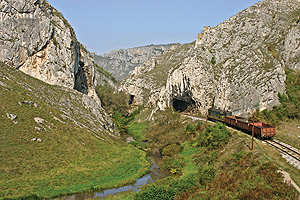 According to the suggestion of the World Bank and IMF, only two railways should remain in Serbia, the one along Corridor 10 and the Bar railway, with the possibility of keeping the Požega–Stalać route. Everything else is canceled as unprofitable and unnecessary. The once dense network of Vojvodina railways died a long time ago, the Danish Royal Train is no longer running, and the route towards Bor was temporarily canceled. At the same time, developed countries are doing everything to make their railway traffic more up-to-date, faster, environmentally friendly and economically justifiable. The experience with the Shargan Eight indicates that railway is becoming more interesting for tourists, and that it is unwise to just remove the rails without thinking. One of the routes intended for canceling is According to the suggestion of the World Bank and IMF, only two railways should remain in Serbia, the one along Corridor 10 and the Bar railway, with the possibility of keeping the Požega–Stalać route. Everything else is canceled as unprofitable and unnecessary. The once dense network of Vojvodina railways died a long time ago, the Danish Royal Train is no longer running, and the route towards Bor was temporarily canceled. At the same time, developed countries are doing everything to make their railway traffic more up-to-date, faster, environmentally friendly and economically justifiable. The experience with the Shargan Eight indicates that railway is becoming more interesting for tourists, and that it is unwise to just remove the rails without thinking. One of the routes intended for canceling is 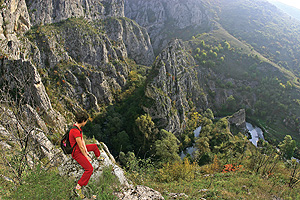 Niš–Svrljig–Knjaževac–Zaječar–Negotin. It is a very picturesque area, especially in the part from Svrljig to Knjaževac. This route which connects the Nišava and the Danube is the one taken by the reporters of National Review, traveling in perhaps one of the last trains. They brought you this story for reading and watching. Niš–Svrljig–Knjaževac–Zaječar–Negotin. It is a very picturesque area, especially in the part from Svrljig to Knjaževac. This route which connects the Nišava and the Danube is the one taken by the reporters of National Review, traveling in perhaps one of the last trains. They brought you this story for reading and watching.
The railway was made in the late XIX century and was a big challenge for architects and even bigger for masons. The biggest obstacles on the route were the limestone massif Tresibabe and the branches of the Svrljig mountains. From Svrljig to Knjaževac, the railway forces its way through the picturesque canyon of the Svrljig Timok. Compared to the winding course of the river, the length of the railway is much shorter, since it passes through 32 tunnels and even more bridges. From the station Podvis to Niševac, the journey resembles the Shargan merry-go-round, only the railway goes straight and the river creates eights around its axis.
TIME MEASURED WITH A PIPE
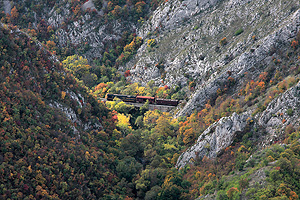 There, from Miljkovac to Palilula and Niševac, winds the most beautiful part of the canyon. The Miljkovac station does not have a station building, nor can a road to the village be noticed. From there to the Palilula station, the railway is three kilometers long, and a bit more down is a beautiful path by the river. The Canyon there is much wider and there are picnickers and fishermen. The village Palilula is part of the Varoš settlement built along the railway. Varoš used to be the lower town and marketplace of the Svrljig City, which ruins on the high rock above the river the locals call Kule. There, from Miljkovac to Palilula and Niševac, winds the most beautiful part of the canyon. The Miljkovac station does not have a station building, nor can a road to the village be noticed. From there to the Palilula station, the railway is three kilometers long, and a bit more down is a beautiful path by the river. The Canyon there is much wider and there are picnickers and fishermen. The village Palilula is part of the Varoš settlement built along the railway. Varoš used to be the lower town and marketplace of the Svrljig City, which ruins on the high rock above the river the locals call Kule.
A long time ago, during the Neogene period, the spacious Svrljig basin was filled with a large lake. The waters of the lake set to the western slope of Tresibaba, a few hundred meters high rock spreading a few kilometers towards the east and the west. Moving around the hard rocks and crumbling the soft ones, the waters forced their way and made an incredibly long and winding path. Today it is the Svrljig Gorge, certainly the most picturesque gorge in Serbia. Exactly there, on a few hundred meters high rock with an unforgettable view of the gorge, the Svrljig City was built.
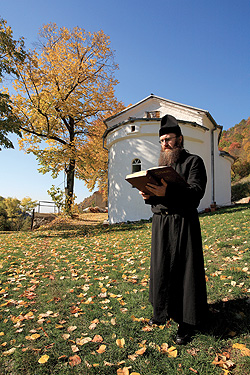 The rock where the Svrljig City was built is surrounded from two sides by the Svrljig Timok, and the river Belica from the third side. The access from the fourth side is narrow and easy to defend. The city was mentioned in the XII century, during the reign of Stefan Nemanja. According to some sources, it was destroyed by the Turkish outlaw Musa in 1412. There is also a story that the local sipahi would always light a pipe when starting to the city. The pipe would burn as long as the trip would last. Thus the previous lower city was named Palilula (”to light a pipe”). The road from Palilula to the City is almost three kilometers long and very steep. Was the Turk fast and skillful as a wild goat, or was the pipe burning too slowly? The rock where the Svrljig City was built is surrounded from two sides by the Svrljig Timok, and the river Belica from the third side. The access from the fourth side is narrow and easy to defend. The city was mentioned in the XII century, during the reign of Stefan Nemanja. According to some sources, it was destroyed by the Turkish outlaw Musa in 1412. There is also a story that the local sipahi would always light a pipe when starting to the city. The pipe would burn as long as the trip would last. Thus the previous lower city was named Palilula (”to light a pipe”). The road from Palilula to the City is almost three kilometers long and very steep. Was the Turk fast and skillful as a wild goat, or was the pipe burning too slowly?
There are numerous caves in the karst canyon, with almost four hundred meters high rocks. One of them is exactly under the city. A small dam was built in the place where the Belica river flows into the Svrljig Timok, and local children like to bathe there in the summer. Besides Belica, Timok receives the warm water from the thermal spring called Banjica, so older locals also come here to heal their rheumatism.
From Banjica to Niševac, the canyon is not so deep any more, nor are the tunnels on the railway that long. Several herbalists are picking the Rtanj tea on the slopes above the railway, for which they claim is even better than the one in Rtanj. Small flocks of famous Svrljig sheep graze around, and women are washing wool in the river. Fishermen are on the banks. Interesting, the first fishermen association in the Federal National Republic of Yugoslavia was founded in Svrljig, which speaks a lot about the quantity and quality of the fish in the Svrljig Timok.
CAVES, SINKING STREAMS, STONE BRIDGES
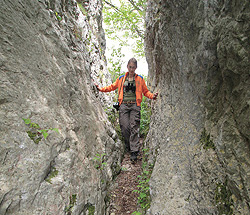 The town of Svrljig is the final destination of this journey. During the time of Prince Miloš, it was a border town and town of rebels. The vicinity of Svrljig was long called Priest Marinko’s Republic, after a priest who led a rebellion against Miloš’s autocracy. That is why it remained an underdeveloped area during the reign of the Obrenović dynasty. In the second half of the XX century, however, at one point the city had more employees than citizens. Memories of the times of abundance is still kept in the ”Kamiondžije” (”truck drivers”) tavern, where sausages and steaks are sold by meter and the hamburger weighs more than half a kilogram. Perhaps it is the right place to end this story, but we still have the road before us. The town of Svrljig is the final destination of this journey. During the time of Prince Miloš, it was a border town and town of rebels. The vicinity of Svrljig was long called Priest Marinko’s Republic, after a priest who led a rebellion against Miloš’s autocracy. That is why it remained an underdeveloped area during the reign of the Obrenović dynasty. In the second half of the XX century, however, at one point the city had more employees than citizens. Memories of the times of abundance is still kept in the ”Kamiondžije” (”truck drivers”) tavern, where sausages and steaks are sold by meter and the hamburger weighs more than half a kilogram. Perhaps it is the right place to end this story, but we still have the road before us.
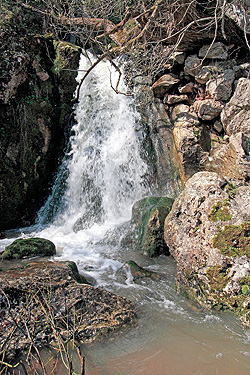 In the immediate vicinity of Svljrig is a place with an unusual name – Kopajkošara. The story goes that the Turks burned down the village, so the villagers lived in dugouts from which they took out soil in baskets. An old village, old houses made of soil and even older inhabitants. Visitors seldom come to the village, but, since the nearby Samar cave entered the Guinness Book of World Records as a place in which the speleologist Milutin spent over a year, the locals are not surprised by visitors and do not ask too many questions. The cave is almost 750 meters long, it has beautiful ornaments and stands at the very edge of the village. Strong jets of water spring under it. In the immediate vicinity of Svljrig is a place with an unusual name – Kopajkošara. The story goes that the Turks burned down the village, so the villagers lived in dugouts from which they took out soil in baskets. An old village, old houses made of soil and even older inhabitants. Visitors seldom come to the village, but, since the nearby Samar cave entered the Guinness Book of World Records as a place in which the speleologist Milutin spent over a year, the locals are not surprised by visitors and do not ask too many questions. The cave is almost 750 meters long, it has beautiful ornaments and stands at the very edge of the village. Strong jets of water spring under it.
In the place it sinks, the river makes an interesting stone bridge named Samar after the cave. It is not easy to reach the sinking spot without a good guide or good navigation. After half an hour of breaking through grown paths, you first hear the rumbling of sinking water and then a three-legged stone bridge appears. One can notice that the stone bridge was part of the cave into which the river sinks. A few hundred meters further is another sinking place, however less attractive than the first one.
***
Bombs, From Below or From Above?
The city which the locals call Kule was well preserved until the bombarding of Serbia by NATO in the spring of 1999. Did it also become a ”collateral” like this whole country, or was it really mined from below by goldseekers from some ancient story, will hardly ever be determined for certain. If those were really people shaken by gold fever amidst the war, did they find anything?
***
Gold Rush Virus
It is known that during World War II, Germans used this railway to transport gold and copper from Bor. Locals tell stories, especially in long winter nights, that some of the wagons never reached their destination and that some goldenrods were found in the Timok at the time. The gold rush virus in Eastern Serbia has been lasting ever since the Roman, Turkish and times of hayduks.
***
Pandiralo
The Svrljig Timok is also interesting at its spring. By the village of Periš, the river disappears in a big dark hole called Pandiralo. Six hundred meters further, on the other side of the village, it again springs in the place the locals call Vrelo. Incredible stories were told about the mysterious Pandiralo. They say that some tried to discover what is hiding in its darkness. They never came back, just like the cattle which the floods would take into the abyss was never seen again.
|
